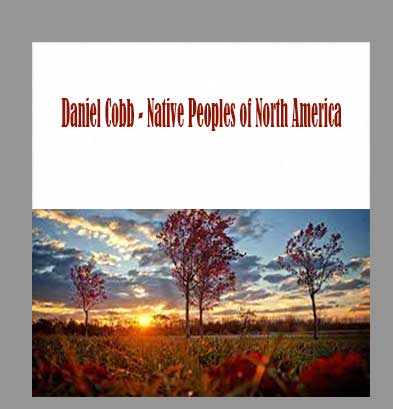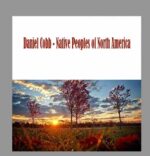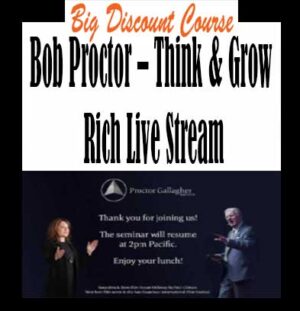Description
Daniel Cobb – Native Peoples of North America download, Daniel Cobb – Native Peoples of North America review, Daniel Cobb – Native Peoples of North America free
Daniel Cobb – Native Peoples of North America
Native Peoples of North America
Join the Smithsonian and an award-winning professor to recount an epic story of resistance and accommodation, persistence and adaption, and extraordinary hardship and survival.
LECTURE (24)
01:Native America: A Story of Survival
You’ll begin by comparing the commonly held views of Native Americans to the realities of what was, and still is, a tapestry of rich and vibrant cultures. Professor Cobb will explain the pitfalls that occur when history doesn’t provide this crucial viewpoint, and will break down the fallacies that result from the common mistake of consigning Native Americans to the past….
02:The Columbian Exchange: New Worlds for All
Explore the how the misleading dichotomy of “Old World†and “New World†has impacted perceptions of Native Americans for decades. Delve into the “Columbian Exchange,†which is the crux behind the creation of “new worlds for all†and learn about the enduring ramifications these processes had in shaping everything from the fauna and flora to the cuisines of the world….
03:The Native South and Southwest in the 1600s
You’ll examine the cultures that existed prior to the Spanish Invasion, the struggle for power through Hernando de Soto’s entrada through the Southeast, and the Pueblo War for Independence in the Southwest. Dr. Cobb introduces the Native American worlds that were born in the aftermath of these transformative events….
04:Werowocomoco and Montaup in the 1600s
Using common material objects as examples, Dr. Cobb demonstrates how connections were forged between Native Americans and newcomers as they incorporated each other into their worlds. In doing so, both cultures were transformed. You’ll examine specific examples across the Northeastern Woodlands down to Werowocomoco, in present-day Virginia, to understand how the search for common ground began at fi…
05:Iroquoia and Wendake in the 1600s
Once Europeans arrived, the Native peoples of the Northeast were determined to maintain their autonomy, despite becoming more integrated with the newcomers. Focusing on the strategies and experiences of the Wendat and Iroquois, you’ll understand how Native Americans transformed the European colonial project while preserving a measured separatism….
06:Indian-European Encounters, 1700-1750
Through an exploration of the Iroquois Confederacy and the Lenape-or Delaware-people in the Northeast, the Great Lakes region-called by the French the pays d’en haut– and the Southeast, you’ll learn how Native Americans kept or lost their lands through treaties, war, and negotiations. In many cases, the repercussions of these conflicts sometimes went beyond relocation, resulting in ensl…
07:The Seven Years’ War in Indian Country
The French and Indian War is often portrayed in history as a crucial turning point for Native nations in the East. In some cases, that is true. For some, it served as a victory, for others a defeat. And for a greater number still it had no immediate impact on their lives. This lecture will change the storyline you’ve heard by exploring the perspectives of Native people who experienced the era quit…
08:The American Revolution through Native Eyes
Examine three ways Native Americans experienced the American Revolution: as allies, as participants in their own civil wars, and as neutral parties. For many Native Americans, the resolution of the American Revolution held little meaning: there would be no liberty for them under the rule of the colonists or the Crown. It was also a period that resulted in treaties and conflicts between Nativ…
09:Indian Resistance in the Ohio Country
Explore how the 1783 Treaty of Paris-which settled the American Revolutionary War between England and the colonists-brought no peace to Native Americans. Programs that were instituted during this period to help Native nations become self-sufficient-such as “expansion with honor†or establishing reservations-ultimately had the opposite effect….
10:Indian Removal: Many Trails, Many Tears
One of the most well-known and dramatic stories in American history is that of the Cherokee nation and the Trail of Tears. Professor Cobb reveals the story behind the story-one of two nations emerging and transforming, during which legal battles, political manipulations, and a clash between the ill-defined limits of federal and state jurisdiction and tribal sovereignty that eventually reached the …
11:Native Transformations on the Great Plains
From John Wayne to Dances with Wolves, we are presented a very distinct view of Native Americans in the West. Professor Cobb presents a profoundly different perspective on this story. From Lewis and Clark’s “discovery†of a West that was an established home for thousands of indigenous people to the three factors that drove more change than anything else in the transformation of Plains cultures-gun…
12:Indians, Manifest Destiny, and Uncivil Wars
The Civil War is a turning point in American history, upholding the Constitutional promises of freedom for … some. One of the pivotal components of the decades leading up to the Civil War was expansion into the West under the doctrine of Manifest Destiny, which drew non-Indians into the West and sparked innumerable conflicts with Native nations. Examine the role Native Americans played in the year…
13:Native Resistance in the West, 1850s-1870s
Delve deeper into the struggle for lands in the Plains between the 1850s and the 1870s. You’ll meet the fighters you’ve heard of, such as Sitting Bull, as well as those you may not have heard about, such as the Hunkpapa Gall, the Oglala Crazy Horse, and the Northern Cheyenne Wooden Leg, who led successful battles and defeated General Custer. You’ll also see the negative repercussions of the …
14:The Last Indian Wars?
Focusing on the Far West, Southwest, and Plateau regions, Professor Cobb examines early laws put in place in California to “control†Native Americans during the gold rush, including state funding to kill or enslave Native Americans. You’ll also meet the “real†Geronimo and learn how he came to symbolize the Chiricahua Apache struggle to maintain independence, as well as Chief Joseph of the Nimi’ip…
15:Challenging Assimilation and Allotment
Reveal how Native Americans adjusted to or refused to give in to the extraordinary challenges and changes they faced during the late 19th and early 20th centuries-specifically the federal government’s deliberate and multifaceted effort to dismantle tribal lands and obliterate tribal cultures through allotment and assimilation. Instead, Native people adopted innovative strategies that allowed them …
16:American Indians and the Law, 1883-1903
Violence and war were not the only options. Even after the alleged “last Indian wars,†Native Americans continued to fight for their rights and lands through the same legal system that had worked towards displacing them. You’ll review three critical court cases, and meet leaders such as Standing Bear and Lone Wolf who stood up against “the courts of the conqueror†and continued to seek justice and…
17:The Ghost Dance and the Peyote Road
Professor Cobb explores how many Native people took matters into their own hands and gained a renewed sense of place, harmony, and balance through two religious movements: The Ghost Dance-often misperceived as the last gasp of resistance before the Indians’ final vanishing act, and the Peyote Road-a critically important pathway to peace, reconciliation, and belonging….
18:Native America in the Early 1900s
Discover how Native Americans confounded the late 19th- and early 20th-century predictions about their inevitable disappearance by getting involved in very public arenas, becoming political actors and writers, artists, and athletes. Professor Cobb tells the stories of Native Americans who broke out of the stereotypes and examines their actions through four concepts: expectation, anomaly, the unexp…
19:American Indians and World War I
Explore Native Americans’ involvement in World War One and how it changed the meaning of citizenship and sovereignty in the beginning of the 20th century. Examine why Native soldiers fought in all of the major offensives after America’s entry into the war, defending a country that was hostile to tribal sovereignty and also reluctant to extend U.S. citizenship to Native people….
20:Making a New Deal in Native America
Uncover some of the hidden histories of the period between the late 1920s and early 1940s as you learn how Native Americans set about making a New Deal for themselves and their communities during an era of uncertainty and convulsive change for the nation at large. You’ll also get an introduction to the Indian New Deal, which helped open the door to greater self-government, economic developme…
21:American Indians and World War II
Move from World War I and the turbulent 30s to World War II to learn how the war and onset of the atomic age transformed the lives of Native Americans. While the challenges and opportunities faced by Native Americans paralleled the ones faced by many other Americans, you’ll learn how the outcomes proved to be vastly different. And you’ll discover Native American heroes of the War, often uncelebrat…
22:Indian Termination or Self-Determination?
Explore American Indian experiences during the early Cold War period, when loyalties were often questioned. Native Americans used the politics of the Cold War era to define freedom through the 1950s and 1960s. Nationalism and decolonization then surfaced as conflicts over fishing rights brought the struggle over Native American treaty rights back into the foreground of American consciousness….
23:Native Radicalism and Reform, 1969-1978
The late 1960s and early 1970s saw the efflorescence of American Indian militancy, beginning with the occupation of Alcatraz Island in 1969, through to the Trail of Broken Treaties in November 1972 and the Wounded Knee occupation in 1973. Professor Cobb will demonstrate how Native American activism intersected with the mainstream movements of the era through literature, music, art, and higher educ…
24:Reasserting Rights and Tribal Sovereignty
Professor Cobb will reveal how tribal nations haven’t settled for survival alone. We are still in the midst of an era of recovery and revitalization-one that has tested the limits of individual rights and tribal sovereignty. He’ll follow a few of the critical sites of contemporary struggle, including gaming, repatriation, religious freedom, federal recognition, self-government, legal jurisdiction,…
DETAILS
Overview
The Great Courses has partnered with Smithsonian to bring you a course that reveals new perspectives on the historical and contemporary experiences of Indigenous peoples and their significant impact on this country. You will gain a new point of view on the seemingly familiar stories America was built on. Be prepared √ this course is going to change how you understand American history.
About
Daniel M. Cobb
“A history of survival emphasizes the durability and integrity of Native America.â€
ALMA MATERÂ University of Oklahoma
INSTITUTIONÂ The University of North Carolina, Chapel Hill
Daniel Cobb is an Associate Professor of American Studies at The University of North Carolina, Chapel Hill. He achieved a B.A. in History with a Sociology minor from Messiah College, where he graduated cum laude; a M.A. in History from the University of Wyoming; and a Ph.D. in History from the University of Oklahoma. He served as the assistant director of the Newberry Library’s D’Arcy McNickle Center for American Indians and Indigenous Studies from 2003-2004 and as Assistant Professor of History at Miami University in Oxford, Ohio, from 2004-2010. An engaged scholar, Professor Cobb has collaborated with tribal communities, worked with elementary and secondary school teachers, and served as a consultant on public history for a consortium of the nation’s leading museums.
Professor Cobb was twice awarded the Commendation for Influence on Students from the Center for the Enhancement of Learning, Teaching, and University Assessment at Miami University and received the Tanner Award for Excellence in Undergraduate Teaching at the University of North Carolina in 2012.
His publications include Native Activism in Cold War America: The Struggle for Sovereignty, which won the inaugural Labriola Center American Indian National Book Award, and Say We Are Nations: Documents of Politics and Protest in Indigenous America since 1887. Among his other works are the coedited volumes Beyond Red Power: American Indian Politics and Activism since 1900 and Memory Matters and a revised and updated fourth edition of William T. Hagan’s classic American Indians.








